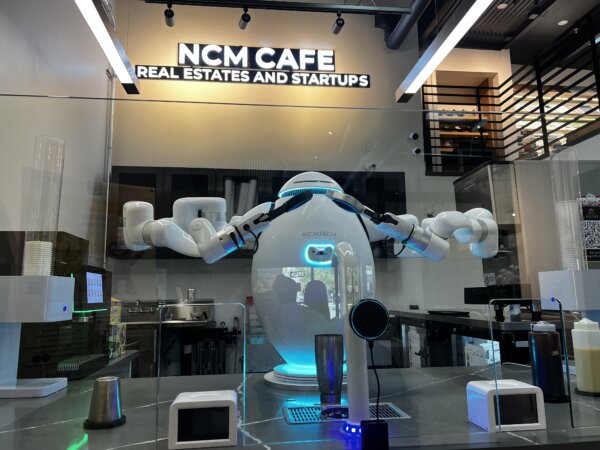 Just as the internet radically changed how America conducts business, artificial intelligence (AI) is also making waves in the workplace by taking thousands of jobs. It’s an outcome that industry experts have warned would happen, and professionals across multiple employment sectors have already been affected.
Just as the internet radically changed how America conducts business, artificial intelligence (AI) is also making waves in the workplace by taking thousands of jobs. It’s an outcome that industry experts have warned would happen, and professionals across multiple employment sectors have already been affected.
Beyond artists and content creators, AI is also impacting professionals in marketing, technology, translation, various levels of administration, and management. It has been a silent and ongoing trend for two years, but tech insiders say this is just the beginning.
A senior software engineer at Microsoft, Nandita Giri, shared her thoughts with The Epoch Times on what kind of near-term changes Americans can expect as a result of ramped-up workplace AI integration.
“AI is particularly effective at replacing routine, predictable tasks … jobs in data entry, customer support, transcription, and logistics are the most vulnerable,” Giri said. “In software engineering, even some junior [developer] testing roles are being replaced or reshaped with AI-driven tooling. Back-office operations across health care, finance, and legal are also at high risk.”
Giri has observed a shift away from human workers in favor of AI in enterprise software development, where she said companies are quietly removing what they call “coordination overhead.” She said this is happening as AI tools become more reliable for things like task triage, scheduling, and summarization.
Restructuring Workflow
Cahyo Subroto, founder of the AI-powered data extraction platform MrScraper, agrees with this perspective.
“I’ve spent the last few years building systems that automate work, so I’ve seen firsthand where AI adds value and where it quietly pushes people out of the picture,” Subroto told The Epoch Times.
Like Giri, Subroto said that the jobs most in danger of AI replacement are those that rely heavily on structured, repetitive digital labor.
“That includes early-stage analysts, junior QA [quality assurance] testers, data entry staff, and even support roles in HR and customer service,” he said.
Subroto explained that when AI can learn workflow patterns, it can perform them faster and without the payroll cost. “At my last company, I watched a client eliminate three QA positions after switching to a tool that could auto-generate test cases and report bugs in real time.”
These decisions are based strictly on efficiency, he added. “That’s what makes this shift so difficult to stop.”
There is a silver lining, however. The WEF—and many others—predict that AI will also create new jobs and reshape existing positions, allowing current employees in various sectors to focus on more high-value tasks instead of routine work.


Jobs with declining demand include customer service representatives, claims adjusters, bank tellers, graphic designers, accountants, and auditors, the WEF report said.
Subroto believes much of the shift toward AI will be subtle. “Instead of replacing people, we’re restructuring the workflow to rely on AI for the mechanical parts, while humans take on broader accountability.”
Big Changes Ahead
In May, Microsoft announced plans to lay off 3 percent of its employees across the board, affecting roughly 6,000 people. In a statement to CNBC, a spokesperson for the tech giant said, “We continue to implement organizational changes necessary to best position the company for success in a dynamic marketplace.” The spokesperson confirmed that the job cuts weren’t related to worker performance.
It’s reportedly the largest series of layoffs at Microsoft since 2023.
This arrives on the heels of reported cuts at Amazon, which in January said it would lay off what it called a “small number” of its communications and sustainability employees. It followed that by announcing in March plans to eliminate 14,000 managerial positions by early next year.
Among those who lost their job at Microsoft is former senior data scientist Tatiana Teppoeva, founder and CEO of One Nonverbal Ecosystem. She told The Epoch Times that increased tech layoffs alongside the rise of AI integration is an industry red flag.
“This has sparked genuine concerns over the future need for human programmers and signals a real, accelerating shift in how companies evaluate which human roles are essential,” Teppoeva said.
Like Giri and Subroto, Teppoeva identified industries that have a lot of unchanging, rules-based tasks like back-end software development, data entry, finance, and logistics as areas with a high probability of AI job replacement.
“The most realistic near-term disruption is task-level automation, not full job replacement,” she said. “For example, in sales, AI tools can draft outreach emails or analyze deal data, but they cannot replicate the human-to-human trust, nonverbal signals, and presence that close high-ticket deals.”
Teppoeva said the human-AI gap is now a point of focus for her business. “Helping sales teams, executives, and companies align their human communication, body language, voice, [and] nonverbal presence [is] what advanced AI tools still can’t do,” she said, then added, “At least not yet.”
On June 2, a Midwest-based web content manager for a major U.S. company—who asked to be identified only as “Tom”—was laid off with the rest of his department and most of the company’s marketing staff. Tom requested the company not be identified out of fear it could affect his severance.
Having worked in web development for more than 15 years, Tom said he saw the “AI blitz” coming and had a gut hunch it would only be a matter of time before he was made redundant.
“The worst part is the lack of honesty,” Tom said. “Companies aren’t being straight with people, they’re just saying things like ’sales are down‘ or ’we need to improve efficiency,’ but the reality is it’s about increasing profit by any means.”
Tom said he has a friend who spent nearly two decades working in marketing and kept up with changing industry trends before being laid off a year ago because of AI integration.
“There are entire careers with university degrees behind them that are ending now,” Tom said.
“It’s not necessarily a one-to-one ratio,” he added. “Maybe an AI tool automates half of a department’s workload. That means you can redistribute the remaining work amongst a smaller team.”


“If the computer and robot can do everything better than you, what meaning does your life have? … In a negative scenario … we’re in deep trouble,” Musk said.
“It’s not like we’re drawing some difficult-to-find conclusion here,” Roetzer said when discussing Microsoft’s most recent layoffs. “If the CTO [chief technology officer] of the company is saying that within five years we expect 95 percent of all code to be written by AI, then what do you need a bunch of engineers for?”
Subroto used an example from his work, describing the use of AI for “task sequencing and code generation,” which allowed his company to launch features faster and fix bugs before users even saw them. However, he said the improved work efficiency came at the cost of no longer needing manual testers checking outputs line by line.
“These were smart, capable people, and yet the structure of the work changed so much that their role no longer made sense,” he said.
The current phase-out of human work roles due to increased AI efficiency is nuanced, but some don’t think it will stay that way for much longer.










